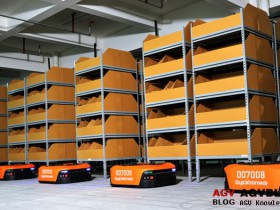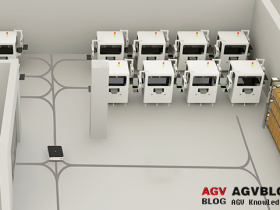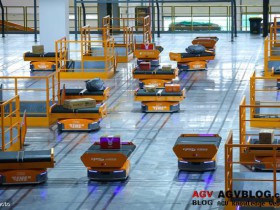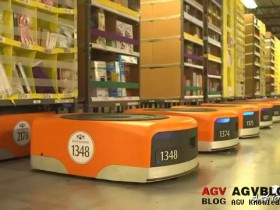Navigation guidance technology is one of the core of AGV technology, which allows AGV to "know" where. There are many common AGV navigation guidance methods, and now it has been matured. AGV navigation has electromagnetic guidance, tape guidance, magnetic nail guidance, two-dimensional code guidance, ribbon guidance, laser navigation, visual navigation, GPS navigation. , mixed navigation, etc. Faced with so many navigation guides, many consumers will wonder what navigation method to choose when deciding to use AGV.
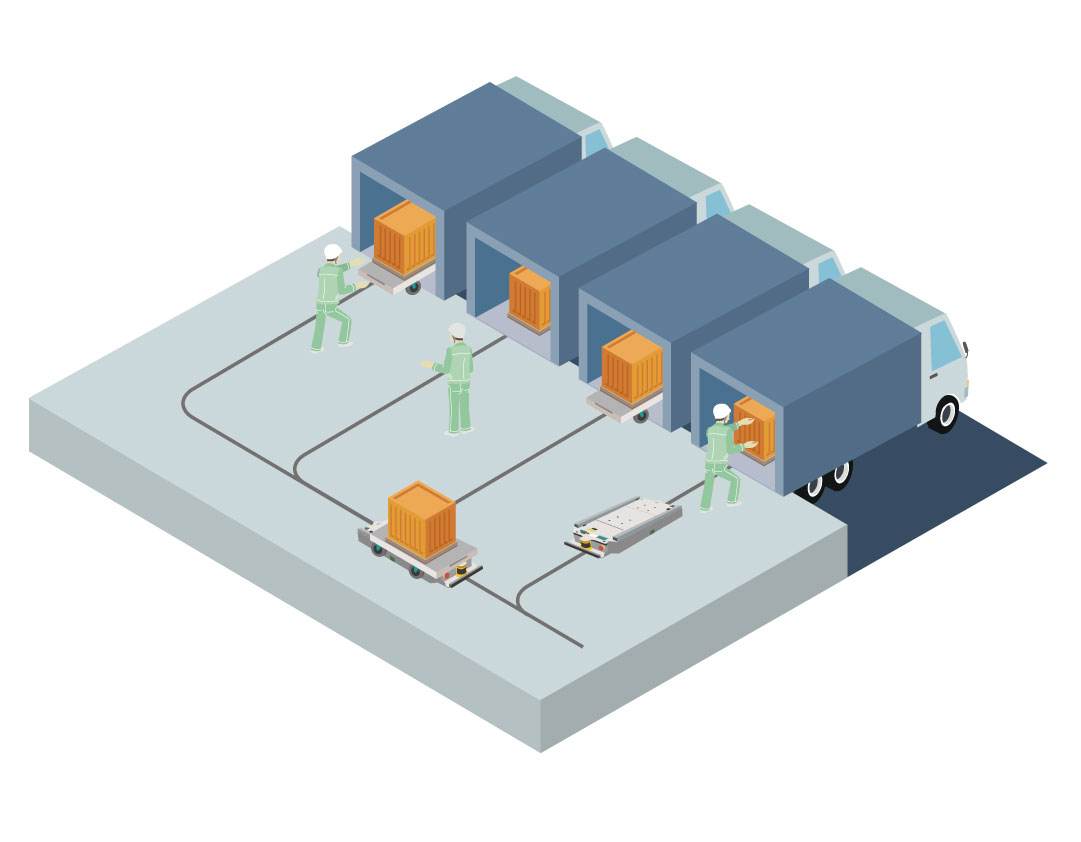
AGV guidance method
The following is a detailed introduction and application scenarios of various navigation guidance methods, which provide reference for consumers to choose appropriate navigation guidance methods.
1. Electromagnetic guidance
Electromagnetic guidance is a relatively traditional guiding method. The realization form is to embed a metal wire on the driving path of the automatic guided vehicle, and load low frequency and low voltage current on the metal wire to generate a magnetic field, and pass the electromagnetic field through the onboard electromagnetic sensor. Strong and weak identification and tracking enable navigation, complete task assignment by reading pre-embedded RFID cards.
The main advantage of electromagnetic guidance is that the metal wire is buried in the ground, which is concealed and is not easily damaged. The guiding principle is simple and reliable, and it has no interference to sound and light, and the manufacturing cost is low. The disadvantage is that the laying of the metal wire is troublesome, and it is difficult to change and expand the path, and the electromagnetic induction is easily affected by ferromagnetic substances such as metal.
Electromagnetic guidance has a relatively simple route and requires a 24-hour continuous operation (such as automobile manufacturing) for a wide range of applications.
2, tape guide
The tape guiding principle is similar to the electromagnetic guiding principle. It is also to lay a magnetic tape on the formal path of the automatic guided vehicle, and the guiding method is realized by the identification of the magnetic field signal by the on-board electromagnetic sensor.
The main advantages of tape guidance are that the technology is mature and reliable, the cost is low, and the tape laying is relatively easy. It is easier to extend and change the path relative to the electromagnetic guidance, and the running line is obvious, and there is no interference to sound and light. The disadvantage is that the path is bare, susceptible to mechanical damage and pollution, requiring regular maintenance by personnel, and is susceptible to ferromagnetic substances such as metals. Once the AGV performs tasks, it can only move along the fixed tape and cannot change the task.
The magnetic strip guide is suitable for the ground embedded type and light load traction state mode, and can be used for non-metallic ground and non-demagnetized indoor environments, and can be stably and permanently operated.
3, magnetic nail guide
Magnetic nail navigation and magnetic strip navigation require a magnetic strip sensor to locate the left and right deviation of the AGV relative to the path. The difference between the magnetic nail navigation and the magnetic strip navigation is that the magnetic strip is continuously laid, and the magnetic nails are discretely laid. If you need to use magnetic nail navigation completely, you need to lay a lot of magnetic nails. The advantages of magnetic nail guiding are low cost and mature technology; good concealment, beautiful navigation with tape; strong anti-interference, abrasion resistance, acid and alkali resistance. The disadvantage of magnetic nail guiding is that the AGV path is susceptible to ferromagnetic materials. The construction of the modified path is large, and the construction of the magnetic nail will have certain influence on the ground. The magnetic nail guiding is applied more on the terminal AGV.
The magnetic nail guide appears in the form of assisted navigation in the products of the Yifeng robot, in order to improve the positioning accuracy of the AGV. The parking AGV designed and manufactured by Yifeng Robot is a laser navigation and magnetic nail guided composite navigation. Laser navigation is used on the AGV driving road, and magnetic nails are installed on the parking spaces with higher precision requirements for precise positioning.
4, QR code guide
The two-dimensional code guides the coordinates of the logo through the two-dimensional code on the ground. The two-dimensional code guide is similar to the magnetic nail guide, except that the coordinate markers are different. The principle of two-dimensional code navigation is that the automatic guided car scans the ground QR QR code through the camera, and obtains the current position information by analyzing the two-dimensional code information. Two-dimensional code navigation is often combined with inertial navigation for precise positioning.
Two-dimensional code navigation is currently very hot in the market. The main reason is that Amazon acquired the KIVA QR code navigation robot at a high price. Its working mode resembling a chessboard is impressive. Domestic e-commerce and intelligent warehouses use QR code navigation robots. . The single-machine cost of the mobile robot guided by the two-dimensional code is relatively low, but a large number of two-dimensional codes need to be laid on the project site, and the two-dimensional code is easy to wear and the maintenance cost is high.
5, ribbon guide
The ribbon guide is a method of setting an optical mark (adhesive ribbon or lacquer) on the form path of the automatic guided vehicle, and acquiring image signal recognition by the on-board optical sensor to realize the guidance. Optical guidance is similar to tape guidance. The main advantage is that the pavement is easier to lay, and the expansion and modification paths are easier to guide and the cost is lower. The disadvantage is that the ribbon is more susceptible to contamination and damage, and the environment is highly demanded. The reliability of the guide is subject to ground conditions, and the positioning accuracy is low.
The ribbon guide is suitable for occasions where the working environment is clean, the ground is flat, and the AGV positioning accuracy is not high.
6, laser navigation
Laser navigation generally refers to laser navigation based on reflector positioning. The specific principle is to install a precise reflector around the AGV path, and the laser scanner will be mounted on the AGV body. The laser scanner travels with the AGV and emits a laser beam. The emitted laser beam is directly reflected back by the multiple sets of reflectors laid along the AGV path. The trigger controller records the angle at which the rotating laser head encounters the reflector. Based on these angle values, the controller matches the actual position of the set of reflectors to calculate the absolute coordinates of the AGV. Based on this principle, very precise laser guidance can be achieved.
The laser navigation method enables the AGV to flexibly plan the path, the positioning is accurate, the driving path is flexible, the construction is convenient, and it can adapt to various practical environments. Since the reflector of the laser navigation is in a relatively high physical position, it is not susceptible to damage. The reflector cannot be shielded during normal operation, otherwise it will affect its positioning. Due to the high cost, laser navigation is not very high in the current AGV market, but due to its superiority, it will gradually replace some traditional navigation guidance methods.
7, natural navigation
Here is the natural navigation, which is also a kind of laser navigation. It also senses the surrounding environment through the laser sensor. The difference is that the positioning mark of the laser navigation (reflector) is a reflector or a reflective column, while the natural navigation can locate the marker. Information such as walls in the work environment does not need to rely on reflectors. Compared to traditional laser navigation, the construction cost and cycle of natural navigation are lower.
Natural navigation can rely on contour information such as walls for positioning, which can effectively reduce the dependence on the reflector and reduce construction costs. The disadvantage of natural navigation is that the dependence on the environment contour is relatively large, and the accuracy is lowered when the contour information on the driving path changes greatly.
8, visual navigation
A method of realizing navigation by acquiring image information of a running area week by an automatic guided vehicle vehicle visual sensor. The hardware needs a down-view camera, a fill light and a hood to support the implementation of the navigation method. The ground texture information can be utilized, and the displacement and rotation between the two images can be calculated based on the phase correlation method, and then obtained by integration. current position.
In this way, the mobile robot captures the ground texture during the moving process to automatically construct the map, and then compares the ground texture information acquired during the running with the texture image in the self-built map to estimate the current position of the mobile robot. Position, realize the positioning of the mobile robot.
Visual navigation AGV is currently used less in the market. The advantages of visual texture navigation are lower hardware cost and accurate positioning. The disadvantage is that the running ground needs to have texture information. When the running area is large, the time for drawing the navigation map is longer than the laser navigation.
9, GPS navigation
GPS (Global Positioning System) navigation is a method of obtaining navigation by using vehicle GPS sensors to acquire position and heading information. The navigation accuracy of GPS navigation is low, and the position error is about 10 meters. GPS navigation is mainly used in the positioning of automobiles, ships, mobile phones, etc., and is used less in indoor AGV positioning with higher precision requirements.
10, inertial navigation
Inertial navigation uses the internal sensors of the mobile robot to obtain the pose. There are mainly optical encoders, gyroscopes, or both. The mobile robot is equipped with a photoelectric encoder on the wheel of the mobile robot. During the movement, the mobile robot uses the pulse signal of the encoder to perform rough dead reckoning to determine the pose of the mobile robot. The gyroscope can be used to obtain the three-axis angular velocity and acceleration of the mobile robot, and the pose information can be obtained by the integral operation, and the two dead reckoning can be combined. The cost of inertial navigation is low, and the positioning accuracy is high in a short time, but the error will accumulate with the motion until it is lost. Therefore, in general, inertial navigation will be used as an auxiliary positioning for other navigation methods.
11, composite navigation
Composite navigation refers to a method of applying two or more guidance (or navigation) methods to achieve automatic guided vehicle operation. For example, the combination of two-dimensional code navigation and inertial navigation uses the inertial navigation short-range positioning accuracy to use the inertial navigation of the navigation blind zone between the two two-dimensional codes. The combination of laser navigation and magnetic nail navigation uses magnetic nail navigation in the position of the station with high positioning accuracy, which increases the stability of AGV positioning. Composite navigation is to make the AGV adapt to the common navigation methods in various usage scenarios, and it will be more and more widely used in various AGVs.
In short, AGV has been used by more and more industries and enterprises as an advanced automated handling solution. There are many navigation methods for AGV. After development, there are their own shortcomings and advantages. It needs to be adapted to local conditions according to actual usage scenarios.

